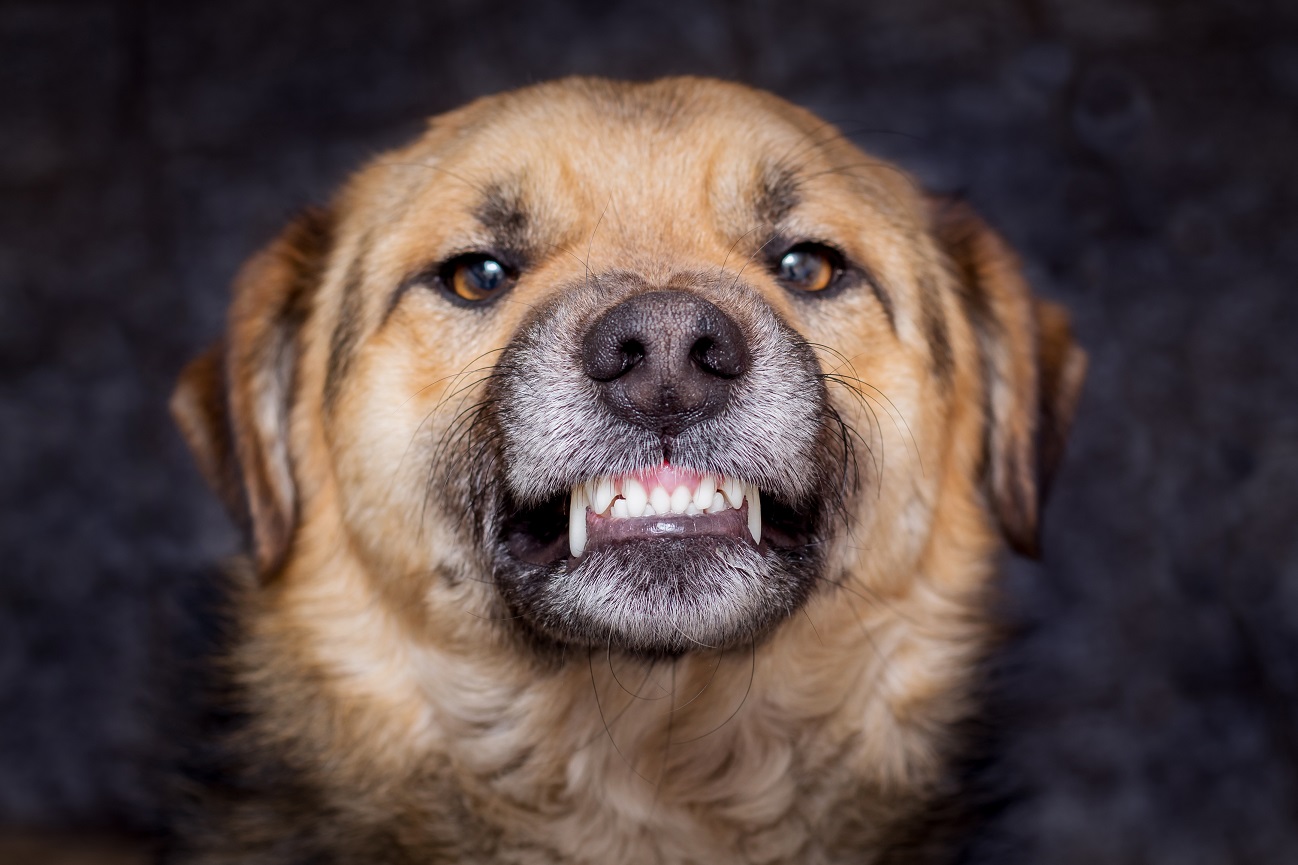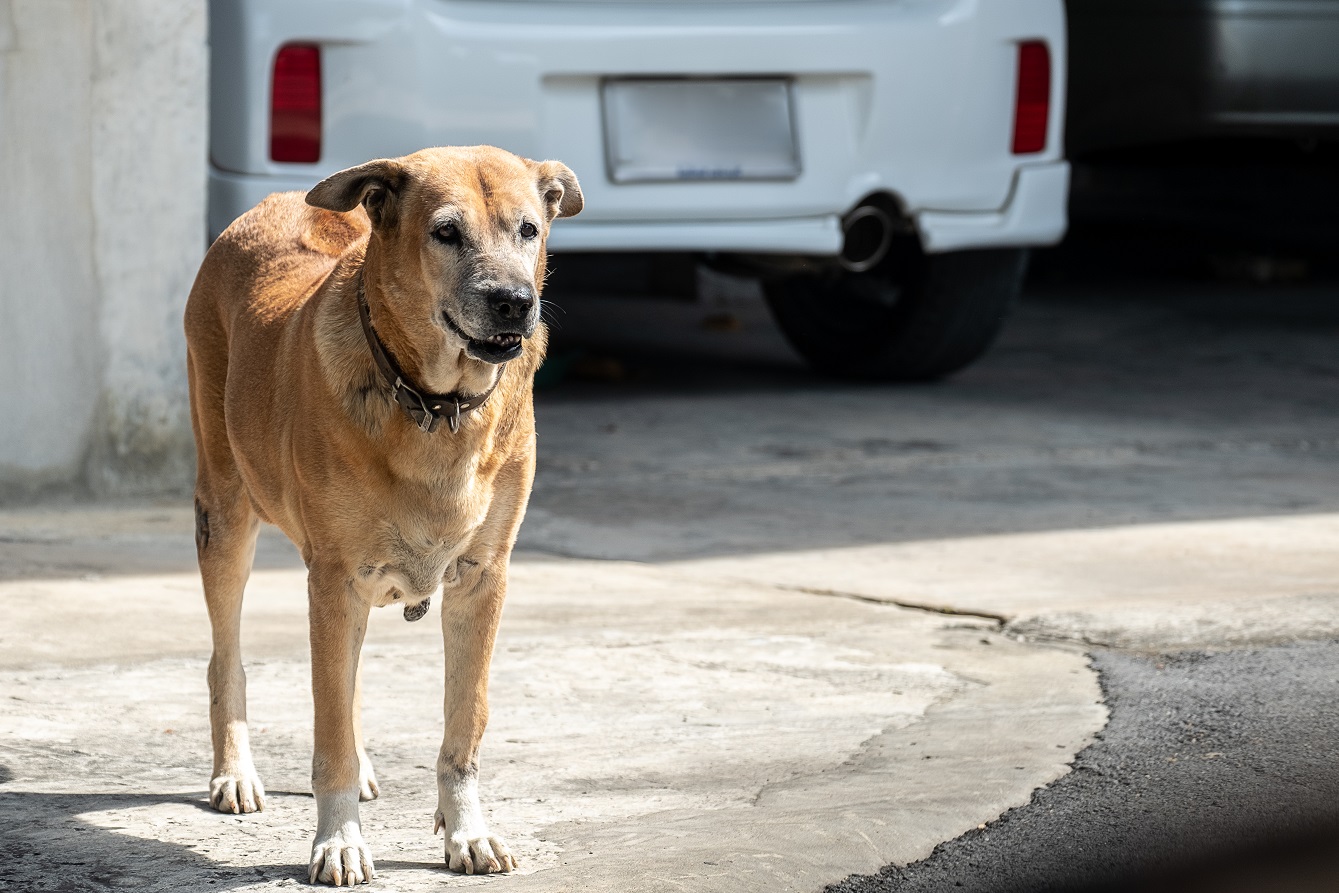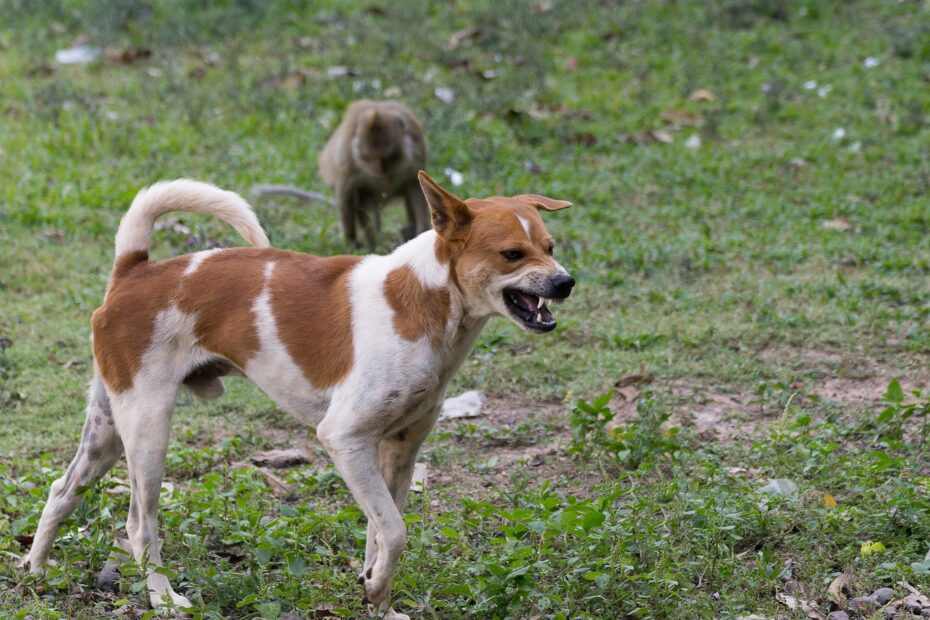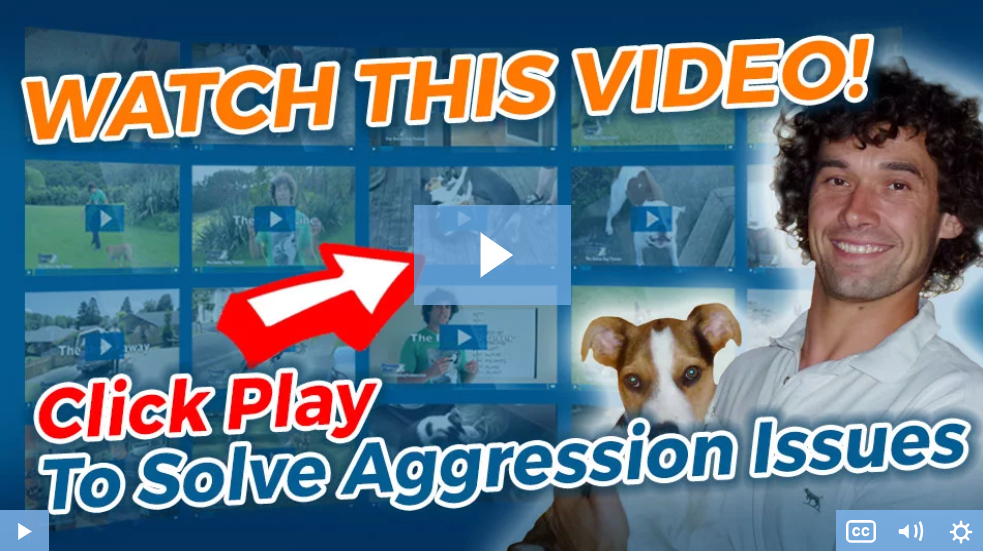If you want to learn how to stop a dog growling at family members, then you’re in the right place.
Because while nobody wants to think of their beloved pooch being aggressive, it does happen. Sometimes more than we care to realize.
Worse still, it can often put huge stress on the relationship you have with your dog… especially when you can’t figure out what’s causing the growling in the first place.
The first step to solving the problem? …understanding it.
Because if you can correctly identify what’s causing the issue in the first place, it’ll much easier to address the underlying issues moving forward.
But first a quick heads up…
Before we get into how to stop your dog’s unwanted growling. It’s important to note that the aim here isn’t to eliminate growling completely.
It is, however, in your best interest to eliminate the wrong type of growling. And the best way to do this is to first teach your dog how to be calm and in control of their emotions.
This is why before you do anything else, I’d highly recommend taking a few minutes to check out the Dog Calming Code from Dan Abdelnoor (aka Doggy Dan) over at The Online Dog Trainer. (see video below)
Watch the video, follow the training Dan recommends, and it’ll quickly improve your dog’s ability to control their growling in any situation that triggers it.
Here’s the link to take a look: Click Here To Check Out The Dog Calming Code And Discover How To Finally Stop Your Dogs Scary Growling Habit… Even If You’ve Tried & Failed Before!
(video will open in a new window)
Why Does My Dog Growl At Family Members?
Dog’s can growl for multiple reasons, and while some forms of growling aren’t a cause for concern (such as a playful growl during a game of tug of war). It’s something that, if not monitored closely, can slowly escalate into potentially dangerous behavior.
Again, the solution isn’t to try and eliminate your dog’s growling completely. After all, while an aggressive growl isn’t the most pleasant sight to witness, it’s still a clear warning that your dog is unhappy and you should back off.
Without this warning, your dog could become prone to unprovoked and unpredictable attacks. Or alternatively, lack the capability to ward off an intruder with a threatening growl should they break into your home.
So the idea here is to focus on managing the behaviors (be it your behavior or theirs) that cause the growling in the first place.
Some of these include…
Territorial Growling
Some dog breeds like German Shepherds, Doberman Pinschers, and Rottweilers are naturally great guard dogs which can often make them territorial by nature.
The problem, however, is that this natural territorial behavior can sometimes present itself in situations that don’t really call for it.
The mailman approaching the door is a classic example. As most dogs will often display obvious signs of territorialism by barking, snapping, and yes, even growling to let them know that their presence isn’t welcome.
However, when this same territorial behavior is directed towards a specific family member who feels the effects of a territorial growl every time they enter the room or sit down on the couch. It’s safe to say that this a problem that needs nipping in the bud sooner rather than later.
Possessiveness
Possessiveness can rear its ugly head in a variety of situations, and it’s not something that’s easily predictable. (at least not at first anyway)
Toys, food, even family members can be a possession if your dog deems them to be. So you need to tread very carefully if you suspect your dog has a distinct obsession with something or someone.
For instance, if your dog becomes particularly ‘growly’ when you approach another member of your family, like your partner or children. It could be that your dog sees that particular person as ‘their possession’ and gives you the clear signal to back off when you approach by growling.
It’s also quite common around the food bowl (more commonly known as resource guarding). Where your dog will become increasingly defensive if you attempt to get near their food.
Dominance
Even though dogs have become domesticated over the years. They are still essentially pack animals. This means there’s always going to be a natural instinct within them to establish their place in the hierarchy.
So if you’re dog only tends to growl at specific family members. It could simply be that they simply rank themself higher in the pecking order. And their growling is just their way to ascertain their dominance over the ‘lesser’ members of the pack.
While it might seem innocent enough at first. If your dog has placed themselves above other members of the household in the hierarchy. Then they could potentially be more prone to aggressive outbursts to people they feel are below them.
Remember those Dog Calming Code I was talking about earlier?
This is where they come in really handy at re-establishing the pecking order in your house.
Because not only will using them calm your dog. They’ll also make your dog highly responsive to whoever uses them while placing them above your dog in the hierarchy.
So if you haven’t done so already, watch the video, implement the exercises, and you should see a marked improvement in your dog behavior for the better.
Related Post: Help! Why Does My Dog Growl At Me For No Reason?

When To Act On Your Dogs Growling
Learning what to do, but more importantly, when to act when your dog demonstrates an obsessive growling habit should always be your first port of call whenever dealing with a situation like this.
Remember, not all growls are created equal. And there’s every chance your dog could be growling at a specific family member out of pure enjoyment or excitement.
However, if you’re unable to distinguish between a playful and aggressive growl, then pay close attention to the next few sentences.
Playful Growling
The body language of a dog that growls during play is the complete opposite of a dog that growls aggressively.
For starters, you should immediately notice that the growl itself is a lot more high-pitched and shorter in duration.
In addition to this, your dogs overall body language will be loose and relax. And can often be accompanied by other playful traits like a wagging tail or sticking their rear end up in the air.
Playful growling is completely normal and isn’t something that should be discouraged.
Aggressive/Warning Growls
On the flip side, a dog whose growling due to aggression will demonstrate an entirely different set of traits.
The growl itself will be a lot lower/deeper and will usually be longer in duration.
Their posture will rigid, with their eyes usually fixated on whatever they’re growling at.
If you notice a slight lip curl, or your dog is showing their teeth, this is another clear warning sign that your need to back off and give your dog a little time and space to calm down.
Related Post: Why Is My Dog Being Aggressive All Of A Sudden?

How To Stop A Dog Growling At Family Members
If left unchecked, growling has the potential to become worse over time, so it’s always going to be in your best interest to zone in on the problem and get it under control.
Remember, the goal isn’t to eliminate growling completely. It’s to teach your dog how to effectively manage the behavior in situations that don’t justify it.
The first step? …understanding why it’s happening.
Establish Why Your Dog Growls
Here’s a simple exercise… Over the next few days, I want you to closely monitor your dog and take a few mental notes (or jot them down) of when your dog growls.
To give you a few ideas:
- Is it directed towards one specific person or multiple members of the family?
- Does your dog growl around food (resource guarding) or at particular times of the day like naptimes?
- Do they only growl when they’re in a specific area of the house, like the kitchen or bedroom?
The idea behind this initial bit of detective work is to give you a clear understanding of WHEN it’s happening.
Because once you’ve learn how to behavior presents itself, you’ll be in a much better position to limit these situations until you can get it under control.
For instance, if your dog only tends to growl in the kitchen (or around food). They could be demonstrating a severe case of resource guarding or natural territorialism in the place where they eat.
If it’s only directed at one or two specific family members. They could be growling to establish their place above them in the hierarchy.
The possibilities here are endless, but by establishing some of the typical scenarios your dog tends to act out, you’ll ultimately have a clearer understanding of what to do about it.
Remove The Triggers
While it’s not wise to ignore growling completely, there can be certain benefits to limiting certain triggers that cause the behavior.
For instance, if your dog tends to growl every time a certain family member comes home from work. Do your dog a favor and shut the blinds so they can’t see them approach.
Or better still, keep your dog in a separate room to avoid any potentially dangerous interactions.
I understand that this is only a temporary solution, and other measures will need to be put in place to deal with the issue effectively.
But for the sake of keeping the peace, limiting your dog’s contact with those they see as a potential threat can be a great way of keeping the peace.
Check Your Own Behavior
It can be easy to point the finger and play the blame game. But have you ever considered the fact that your dog might not be the initial cause of the aggression?
For example, if you have small children in the home, it’s not uncommon for them to be fascinated with their beloved pets and want to play with them at every opportunity.
The problem with this, however, is that kids tend to push the boundaries more than we care to realize. And while a child might find it fun to pull the dog’s tail or probe them with a finger, your dog probably won’t take too kindly to being used as a human plaything.
The result? …a grouchy dog that that growls to send them a clear warning to back off.
Teach Your Dog Emotional Control
While not an overnight fix for your dog’s persistent growling. Teaching your dog how to be calm and in control of their emotions should be the first thing on your to-do list if you want any chance of solving the issue long term.
To elaborate further, there is one particular exercise Dan talks about in great detail called the calm freeze.
Basically, it’s a simple technique that involves (very gently) taking hold of your dog’s collar directly underneath their chin.
The idea here is that once contact with your dog is made, you’re essentially transferring your calm energy to them, which eventually helps them follow suit.
Obviously, you’ll have to be in a calm state yourself for this to have the desired effect.
But I think you’ll be surprised at how this easy-to-implement exercise can work wonders for instantly calming your dog’s emotions.
If you want to see it in action, it’s just one of the many things Dan demonstrates in The Dog Calming Code.
So if you haven’t done so already, I’d highly recommend taking a look to see how it can help.

Wrapping Things Up
By applying some (or all) of the above, I have no doubt that you’ll slowly start to see an improvement in your dog’s behavior for the better.
Just remember that while growling does have its place in your dog’s vocabulary. You should always proceed with caution and never approach your dog if their growling is that of an aggressive nature.
If you’re ever unsure, it’s always wise to consult a certified dog training or behavioral specialist to see what they can do for you.
But eventually, with the right amount of time, patience, and consistency, their aggressive nature will soon be a thing of the past.

